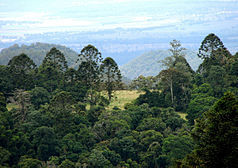Bunya Mountains National Park
| Bunya Mountains National Park | ||
|---|---|---|
| Bunya Pines | ||
|
|
||
| Location: | Queensland , Australia | |
| Next city: | 63 kilometer (s) from Dalby | |
| Surface: | 192.3 km² | |
| Founding: | 1908 | |
| Address: | Queensland Parks and Wildlife Service | |
The Bunya Mountains National Park is a 192 square kilometer national park in southern Queensland , Australia . The park covers large parts of the mountain range of the Bunya Mountains of the same name . The mountains are covered with forests that are typical of the west and contain the largest contiguous Bunya pines worldwide. The park is located 63 kilometers northeast of Dalby and 58 kilometers southwest of Kingaroy .
The park is accessed via a narrow, winding road and is known for its wildlife and views. The mild climate of the mountain range ensures that temperatures are low in the morning and evening. It offers campsites , picnic areas and a network of hiking trails.
history
The Aborigines of the Waku Waku tribe were the first to colonize these mountains. During the 1860s, logs began to be cut in the park, mainly red cedar , Queensland araucarias and New Guinea araucarias , the Aborigines were ousted. In the same decade, European settlers began to visit the park and enjoy the landscape.
The Bunya sawmill opened in 1883. In 1908, 9,112 hectares were declared a national park, making it the second oldest national park in Queensland. However, wood was felled until 1917. The last sawmill in the Bunya Mountains closed in 1945.
The first hiking trails were created in 1939. The Carbine's Chute was one of the first chutes used to transport logs out of the mountains. From Munros Camp there is a 1.5 km path to this point. Since the wood often splintered and was damaged as it slid down the steep gullies, the owner of a sawmill, Lars Anderson, used a combination of railways, winches , conveyor belts and rope bridges to move the wood more gently.
flora
Some of the bunya pines in the park are up to 600 years old and 25 meters tall. Large nettles , wild raspberries , a variety of creepers and ferns can be found in the forests . Other tree species in the park include White Beech and Silky Oak . The grass trees on Mount Kiangarow reach heights of up to 5 m and are several hundred years old.
Throughout the national park you will find clearings in the woods, known as grassy balds . They are typically a few hectares in size and either arise from bushfires or are caused by geological features . For example, where large basalt slabs lie in the ground and thus block the path for the roots of the trees. At the moment there are about 100 of these clearings, although those created by fire are slowly receding because there has been no fire here for a long time. The grassy areas have a higher biodiversity than the dense rainforests , as many birds and rodents live here that are not found anywhere else in the park.
fauna

The park is home to more than 200 species of frogs and reptiles , but also marsupials such as filanders , rock kangaroos , swamp wallabies and the Bunya Mountains ring pouches ( Pseudocheirus peregrinus rubidus ). Some snake species are also common here, such as the diamond python , the red-bellied black otter and the brown night tree snake .
The mountains are part of the Bunya Mountains and Yarraman Important Bird Area , which is believed to be home to the world's largest population of the black-breasted button-quail . There are a total of 120 species of birds, including wedge-tailed eagles , bush grouse , eastern whipbirds , king parrots , silkworms , hawks and finches . The park is also home to important populations of the green arborebird , the yellow-naped bowerbird, and the shield bird of paradise . There are also currawongs , noise pittas , pennant parakeets , and wong pigeons .
Web links
- Official site of the park (English)
Individual evidence
- ↑ Australian Government - CAPAD 2010 ( MS Excel ; 170 kB), DSEWPaC , accessed on January 7, 2013 (English)
- ↑ Explore Queensland's National Parks . Explore Australia Publishing, Prahran, Victoria 2008, ISBN 978-1-74117-245-4 , pp. 42 .
- ↑ Australia Easy Read - Road and 4WD Atlas . Hema Maps, Brisbane 2007, ISBN 978-1-86500-395-5 .
- ↑ a b Hema Maps: Discover Australia's National Parks . Random House Australia, Milsons Point, New South Wales 1997, ISBN 1-875992-47-2 , pp. 162 .
- ↑ a b c d e f Bunya Mountains National Park: Nature, culture and history. (No longer available online.) Department of Environment and Resource Management, Aug 6, 2010, archived from original on Nov. 27, 2012 ; Retrieved August 4, 2011 . Info: The archive link was inserted automatically and has not yet been checked. Please check the original and archive link according to the instructions and then remove this notice.
- ↑ a b c d e Peter Shilton: Natural Areas of Queensland . Goldpress, Mount Gravatt, Queensland 2005, ISBN 0-9758275-0-2 , pp. 211-214 .
- ^ Department of Environment. (1996). Bunya Mountains National Park Visitor Information State of Queensland.
- ↑ a b Jane Stapleton, Roger Penny: A Walk in the Park: Queensland . ABC Audio , 2007.
- ↑ IBA: Bunya Mountains & Yarraman. In: Birdata. Birds Australia, accessed June 8, 2011 .


